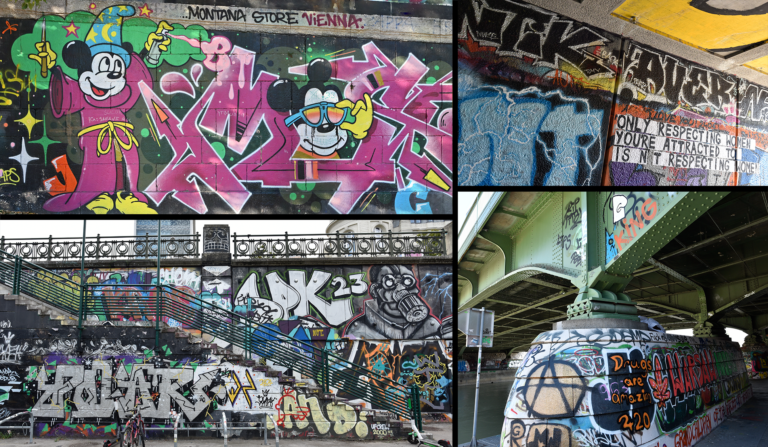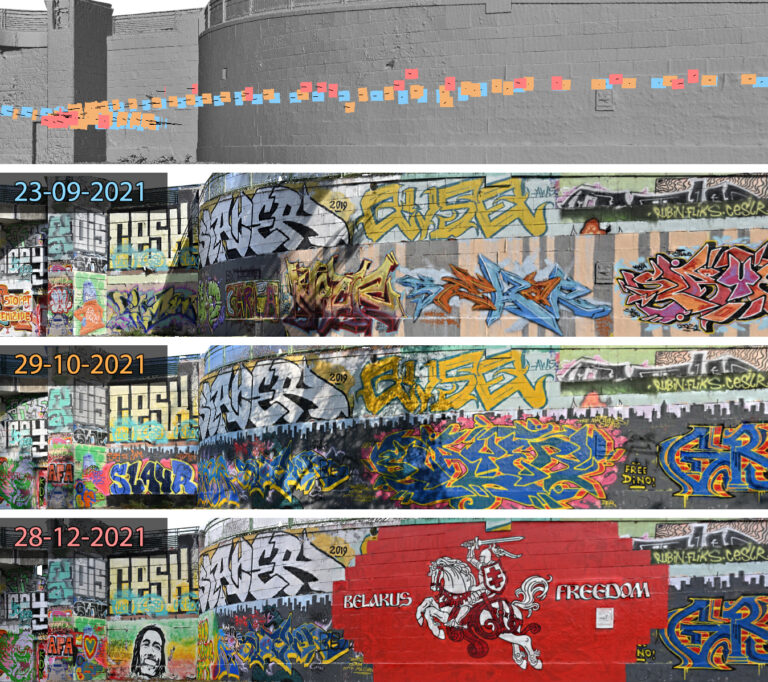INDIGO
INventory and DIsseminate Graffiti along the dOnaukanal
Graffiti is a short-lived form of heritage balancing between tangible and intangible, offensive and pleasant. Graffiti makes people laugh, wonder, angry, think. These conflicting traits are all present along Vienna’s Donaukanal (Eng. Danube Canal), a recreational hotspot – located in the city’s heart – famous for its endless display of graffiti.
The two-year INDIGO project aims to build the basis to systematically document, monitor, and analyse 13 km of Donaukanal graffiti in the next decade. Combining the local graffiti community’s engagement with regular visits along the Canal ensures that most graffiti gets colour-accurately photographed soon after their creation. A bi-annual total photographic coverage should pick up most of the remaining graffiti. All images are processed into detailed, distortion-free orthophotographs and textures for the canal banks’ 3D surface model (provided by the City of Vienna). In this way, INDIGO will build a spatially, spectrally, and temporally accurate record of all possible sprayings, engravings and other works of personal expression attached in (il)legal ways to the public urban surfaces of the Donaukanal.
The OpenAtlas spatial database manages all these data, along with auxiliary data (like videos) and relevant metadata such as style, artist pseudonym, and creation data. INDIGO ensures (meta)data correctness and completeness through the graffitists’ essential involvement and collaboration with local and international scholars. The CIDOC CRM ontology and a novel thesaurus facilitate a semantic database structure with hierarchical, graffiti-related terms.
This database represents a spatio-temporal inventory of all graffiti along Vienna’s central waterway, thus explaining the project’s title INDIGO: IN-ventory and DI-sseminate G-raffiti along the D-O-naukanal. The dissemination part is taken care of by a freely accessible online platform that enables scholars, graffitists, and non-specialists alike to visualise, explore, and query graffiti inside the INDIGO database. This web-based interface allows virtual walks along the Donaukanal or the display of graffiti through time, while simultaneously supporting spatio-temporal-semantic questions like “where were all political messages from 2021 located” or “which graffiti was visible for more than three months and featured animals”. In this way, INDIGO enables cultural, ethical, legal, or political assessments of graffiti. Simultaneously, its database size also invites the development of methods to mine and analyse extensive image collections.
Since storage in the ARCHE repository ensures the necessary digital longevity and free download of all data, INDIGO can realistically preserve and disseminate society’s thoughts and artistic expressions marked upon its walls.
- Funding programme ÖAW Heritage Science Austria
- Project lead LBI ArchPro – TU Wien
- Project partners 7
- Duration 09/2021-08/2023




